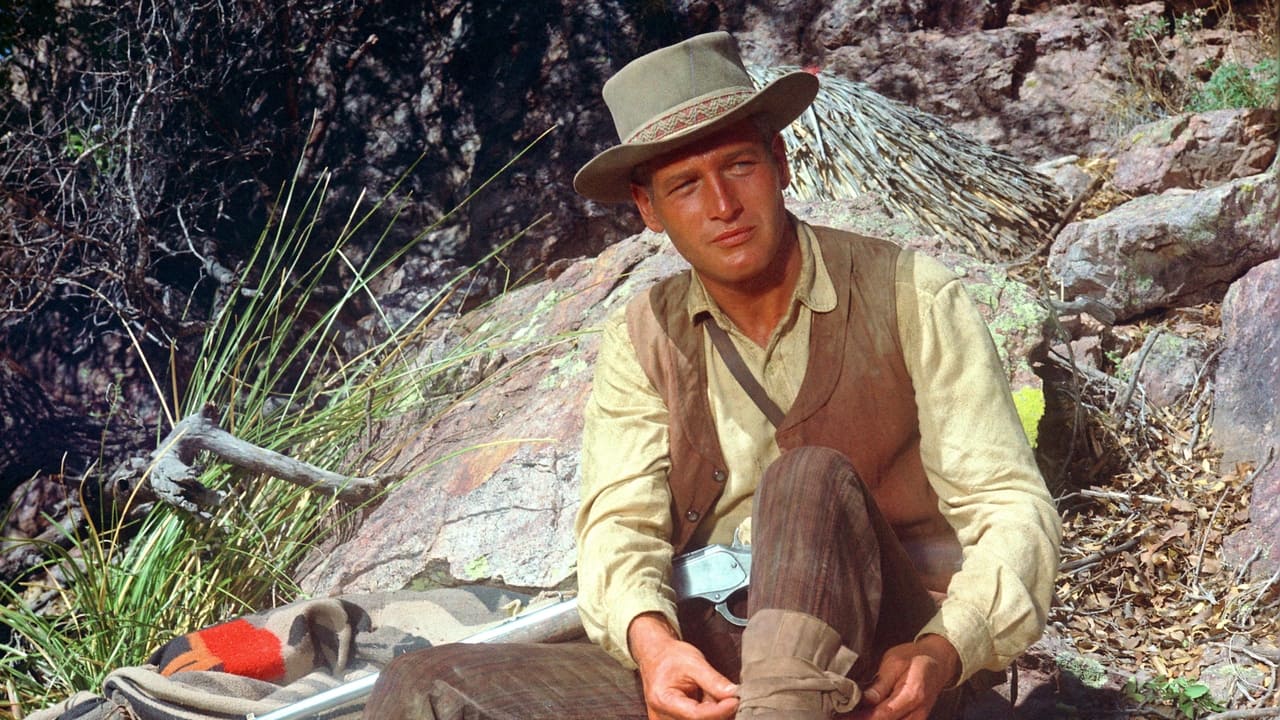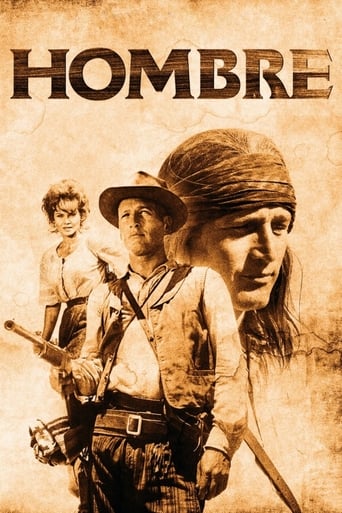Leofwine_draca
HOMBRE is a very good American western featuring Paul Newman, hot off Cool Hand Luke, in the title role. If Cool Hand Luke saw Newman at his deepest and most emotional, HOMBRE sees him playing a totally different part: ice cold, his feelings hidden beneath a tough and leathery old skin. He plays a white man raised on an Apache reservation and thus suffering the scorn of his fellows. He ends up taking a fateful trip on a stagecoach waylaid by bandits and must use his survival skills to help keep his fellow passengers alive.The film has a leisurely pace and a long set up, but everything works well here. Each character has a little story all of their own and the actors centre the roles well. Diane Cilento is particularly good as the damaged woman that Newman butts heads with, but the likes of Fredric March, Cameron Mitchell, and Martin Balsam don't disappoint either. Richard Boone is particularly imposing as the chief villain in the story, and the action is handled expertly with some great twists and turns along the way.
lavatch
"Hombre" is a motion picture combining the talents of two veterans of the famed Actors Studio in New York: director Martin Ritt and actor Paul Newman. The final movie in their multiple film collaborations, "Hombre" tells a good story with a nuanced message about the treatment of Native Americans.Newman plays the character named John Russell, whose background is that of a native of the Cherokee nation. Raised in the Cherokee culture as a boy, Russell now is starting out to make his way in the world of the men who destroyed his native culture.The action of the film is a lengthy story of survival where Russell is part of an entourage in a stagecoach that is robbed. The large stash of money was originally stolen by a doctor employed by the government to oversee the Cherokee reservation. Now, some desperadoes, led by Richard Boone in a star turn as the villain, attempt to rob the doctor. The money really belongs to the Russell's tribe, yet he is now in forced to choose whether or not to assist the bystanders in the stagecoach in a long march across the desert.SPOILER ALERT: The drama has some enormous plot holes, including the unexplained moment when the stagecoach is robbed, yet the thieves do not remember to take the money! Then, in the climax, Newman's character plans to kill the robbers, yet he too does not take the money bag that is to be offered for the exchange of the doctor's wife.Beyond the muddled narrative, the scenery of the Southwest is gorgeous, and Newman turns in an exemplary performance, especially in his understated reading of some excellent lines of dialogue.
tieman64
"The Indians must conform to 'the white man's ways', peaceably if they will, forcibly if they must. They must adjust themselves to their environment, and conform their mode of living substantially to our civilisation. This civilisation may not be the best possible, but it is the best the Indians can get. They cannot escape it, and must either conform to it or be crushed by it. The tribal relations should be broken up, socialism destroyed, and the family and the autonomy of the individual substituted." - Commissioner Thomas Morgan Director Martin Ritt and actor Paul Newman made several films together. One of their best was "Hombre", a 1967 revisionist western. The film's a masterpiece of the genre, but receives little notice today.The plot? Newman plays John Russell, an Apache-raised white man living in 19th century Arizona. When his father dies, Russell learns that he has inherited a house and land in the town of Bisbee. The film's first act thus watches as Russell – essentially emblematic of persecuted Native Americans – journeys out of the wilderness, sets upon his new home and struggles to acclimatize to both modernity and western civilisation.The film's second act then leaps off into another director. Here Ritt introduces us to a number of wildly divergent characters. Foremost amongst these is Jessie (Diane Cilento), a middle aged woman who struggles to survive in the Arizonan deserts. Hardened by time, she's a unique mixture of self-sufficiency and neediness. Like the other two women in the film – one wealthy, one a pauper, both sexually dissatisfied – she's also been repeatedly burnt by men. Mirrored to the three women are men in positions of power. One's a soldier, one's a sheriff, one's a professor in charge of taking care of Indian Reservations (essentially concentration camps in which Native Indians were housed). Each character betrays his position of authority and reveals himself to be a corrupt, selfish brute. By the film's end, the only positive male roles will be assigned to a Mexican man, Henry Mendez, and Newman's John Russell, both marginalized or minorities.The film's third act then essentially becomes an existential morality play. Here the film's title, which means "man" in Spanish, alludes to mankind in a more generalised, philosophical sense. In Ritt's hands, all men, and indeed all civilisational institutions, are seen to be inherently corrupt. Because we view the world through John Russell's eyes, a man who has been persecuted all his life and who has learnt to both keep his distance and view others with apathy and scorn, Ritt's nihilistic stance is seductive. This easy seduction is questioned, though, during the film's highly abstract final sequences, in which community, altruism and self-sacrifice are positioned on one hand, and ego, individualism, apathy and selfishness are positioned on the other. Various characters are asked to jump from one extreme to the next, but it's only John Russell who makes the leap, risking his life to save men and women who'd readily watch others rot if it made them a buck.What's odd about "Hombre" is how much it says about the treatment of Native American Indians without actually being about Native American Indians. The film's racism is mostly alluded to and treated as unspoken, psychic ripples. Elsewhere there are possible allusions to then contemporary civil rights issues (Russell excluded to the top of a stagecoach, like African Americans shunted to the backs of buses), and it is hinted that it's not Russell who has come to civilisation, but he who brings civilisation to Arizona; he who shows "them" how to act like a "man", and "they" who must learn to conform to him.One must remember that Ritt was once a radical leftist who had loose affiliations with various communist or left-leaning movements, a fact which got him blacklisted during the Hollywood's horrible Witchhunt Years. Ritt's films can themselves be divided into loose groups. One group tends to be preoccupied with watching as characters, who represent the modern ethos of capitalism, come into contact with their opposites ("Hud", "Hombre" etc). Another group focuses on the lives of the marginalized, often African Americans who struggle with various socio-economic problems ("Sounder", "Conrack", "The Great White Hope" etc). Yet another chunk of Ritt's films tend to deal with groups or organisations being infiltrated and undermined by the literal or figurative foot-soldiers of either communism or capitalism ("Norma Rae", "The Spy Who Came In From The Cold", "The Molly Maguires"). "Hombre" belongs to the first group, but Newman's character is also very much like the spies of "Cold", "Molly" and "Norma Rae", infiltrating groups and changing them from within."Hombre" was shot in Death Valley and around the Halvetia Mines. It features some fine photography by James Wong Howe, director Martin Ritt's camera work is simple but classy, Richard Boone impresses as a craggy villain, and the film, quite interestingly, moves from melodrama to abstract, philosophical ordeal, its characters slowly dying, dehydrating and climbing absurd stairs seemingly torn out of the Myth of Sisyphus. Unsurprisingly for a film derived from a book by Elmore Leonard, the film's dialogue offers a kind of blunt poetry.Incidentally, this period saw a number of excellent revisionist westerns ("Sitting Bull", "McCabe", "Bad Company", "Soldier Blue", "Little Big Man", "The Great Northfield Minnesota Raid", "Broken Lance", "Hud" etc). Most of these films are overlooked when discussions on Westerns arise. Those westerns which are praised, in contrast, tend to merely be giant allegories for the passing of an era and its assorted totems. Nostalgic (and oft reactionary) films which pine for a specific type of outlaw masculinity, most of these Westerns are thin (Leone, Ford, Peckinpah etc), using steam-engines, railways, machine guns, or blaze of glory bloodbaths as clunky "metaphors" for what is essentially the death of a false image.8.9/10 – A strong Western, marred only by silly early scenes featuring Newman in a wig. Worth two viewings.

